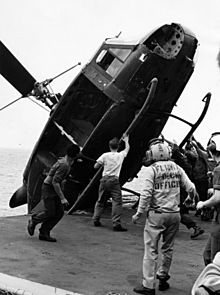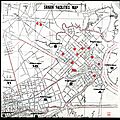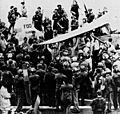Operation Frequent Wind facts for kids
Quick facts for kids Operation Frequent Wind |
|||||||
|---|---|---|---|---|---|---|---|
| Part of the Fall of Saigon, Vietnam War | |||||||
 A South Vietnamese helicopter is pushed overboard from USS Okinawa to clear deck space for more incoming helicopters |
|||||||
|
|||||||
| Belligerents | |||||||
| Commanders and leaders | |||||||
| Vice Admiral George P. Steele Lieutenant General Richard E. Carey |
General Văn Tiến Dũng | ||||||
| Casualties and losses | |||||||
| 2 killed in action 2 missing at sea |
Unknown | ||||||
Operation Frequent Wind was a big rescue mission. It was the final step to help American citizens and Vietnamese people who were in danger leave Saigon. This happened just before the city was taken over by the North Vietnamese army.
The operation took place on April 29-30, 1975. This was during the very last days of the Vietnam War. Over 7,000 people were flown out of Saigon by helicopter. This huge airlift created many famous pictures.
Contents
Planning the Escape
Evacuation plans were already in place for American embassies. These plans were a normal safety procedure. In early March, planes started flying civilians out of Tan Son Nhat Airport. They flew to nearby countries for safety.
By mid-April, special plans were ready for a helicopter evacuation. The collapse of Saigon seemed very close. The U.S. Navy gathered a group of ships called Task Force 76. They waited off the coast near Vũng Tàu. Their job was to help with the helicopter evacuation. They were also ready to provide air support if needed.
The North Vietnamese army paused outside Saigon for about a week. This allowed most Americans to leave the city safely.
The Evacuation Begins
On April 28, Tan Son Nhut Air Base was attacked. Planes and artillery shells hit the base. Because of this, the plane evacuations had to stop. Operation Frequent Wind then began.
Before this, 50,493 people had already left Tan Son Nhut by plane. This included 2,678 Vietnamese orphans. The helicopter evacuation started around 2:00 PM on April 29. It mostly happened from the Defense Attaché Office compound.
The evacuation ended that night. There was only minor damage to the helicopters from small guns. The U.S. Embassy in Saigon was meant to be a backup evacuation spot. But it quickly became crowded with many people wanting to leave. The embassy evacuation finished at 7:53 AM on April 30. However, some Americans chose to stay. About 400 people from other countries were also left behind at the embassy.
Mass Exodus by Air and Sea
Many thousands of Vietnamese people also escaped by themselves. They left by sea or air. As South Vietnam fell, many boats and ships sailed away. Helicopters and some planes from the Republic of Vietnam Air Force (RVNAF) also flew to the evacuation fleet.
Helicopters started to fill up the decks of the ships. Some helicopters had to be pushed overboard to make space for more to land. Pilots of other helicopters were told to drop off their passengers. Then, they would fly out over the sea and ditch their helicopters. They would then be rescued from the water.
In Operation Frequent Wind, 1,373 Americans were evacuated by helicopter. Also, 5,595 Vietnamese and people from other countries were evacuated. In total, 138,869 Vietnamese people were evacuated by this operation or escaped on their own. They were then processed as refugees to enter the United States.
This operation was also the first time the F-14 Tomcat aircraft was used in a real combat mission.
Brave Sacrifices
Considering how big and complex Operation Frequent Wind was, there were not many casualties. Marine corporals McMahon and Judge were killed at the DAO compound. They were the only U.S. forces killed during the operation. They were also the last U.S. ground casualties in Vietnam.
A Marine AH-1J SeaCobra helicopter ran out of fuel while looking for USS Okinawa. It crashed into the sea. Its two crew members were saved by a boat. Another helicopter, CH-46F Swift 1-4, crashed into the sea. This happened as it was approaching the USS Hancock. The two crew members survived, but the pilots' bodies were not found. The reason for this crash was never discovered.
Remembering the Event
After the embassy was torn down, a metal staircase was saved. This staircase led from the rooftop to the helipad. It was sent back to the United States. Today, you can see it on display at the Gerald R. Ford Presidential Museum.
The Cessna O-1 Bird Dog plane that Major Buang landed on USS Midway is now on display. You can see it at the National Museum of Naval Aviation in Florida. The USS Midway itself is now a museum ship in San Diego. Lady Ace 09, a CH-46 helicopter, is on display at the Flying Leatherneck Aviation Museum in San Diego, California.
In Popular Culture
On April 29, 1975, a photographer named Hubert van Es took a famous picture. It showed an Air America helicopter on a rooftop picking up Vietnamese people. This building was the Pittman Apartment building. It was used by people from the embassy and other U.S. agencies. Many people mistakenly thought it was the U.S. Embassy. Hubert van Es's photo is often used in political cartoons.
The musical Miss Saigon shows events leading up to and during Operation Frequent Wind. The main characters get separated because of the evacuation. The writer, Claude-Michel Schönberg, said the musical was inspired by pictures of the evacuation. Hubert van Es thought Miss Saigon used his photo without permission. He thought about taking legal action but decided not to.
In The Simpsons, an episode shows the Simpsons being evacuated from an American Embassy. This scene looks like Hubert van Es's famous photo. Homer asks if they are going to an aircraft carrier. He is told they are going to a laundry ship instead.
The 2014 PBS documentary Last Days in Vietnam is also about this operation.
Images for kids
-
South Vietnamese refugees arrive on a U.S. Navy vessel during Operation Frequent Wind.
See also
 In Spanish: Operación Frequent Wind para niños
In Spanish: Operación Frequent Wind para niños

























